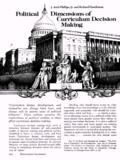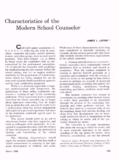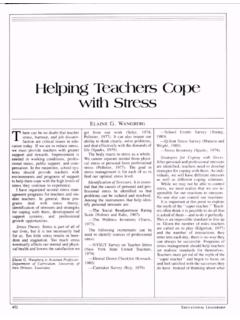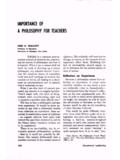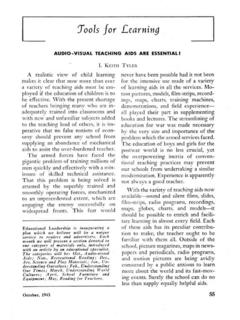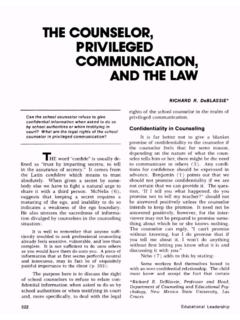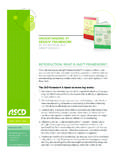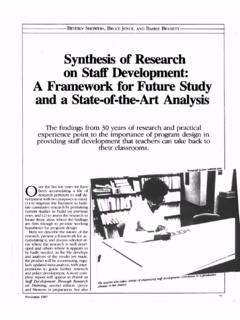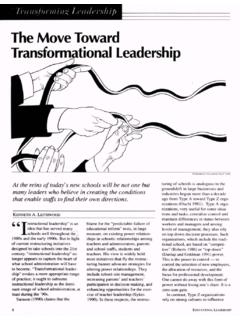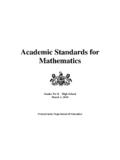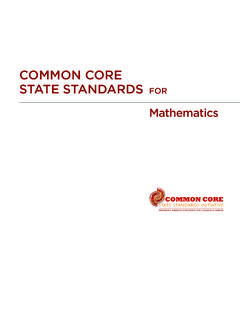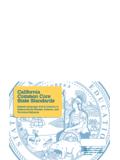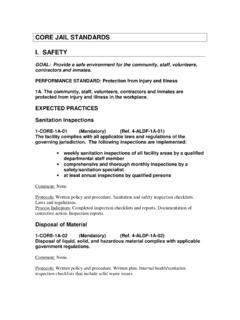Transcription of A Whole Child Approach to Education and the Common …
1 A Whole Child Approach to Education and the Common core State standards Initiative A Whole Child Approach to Education is defined by provides the silver bullet for school improvement, but policies, practices, and relationships that ensure each rather that the application of Child -adolescent growth Child , in each school, in each community, is healthy, and development theory in the context of learning safe, engaged, supported, and challenged. It engages within a specific community creates the opportunity for all stakeholders educators, families, policymakers, each Child to succeed.
2 And community members in defying the percentage proficient culture of too many school reform efforts, to The Common core State standards Initiative is a critical focus on each Child . And it further raises the bar of ac- step toward ensuring such an Approach . For too long in countability beyond narrow, single-issue improvement too many schools, young people have been provided a strategies to efforts that reflect the broad array of factors learning experience that so undermotivates, underedu- influencing long-term success rather than short-term cates, and underprepares that they are left reaching for achievement.
3 Remedial preparation for the careers, further Education , and civic participation they seek. In the worst situa- Within a Whole Child Approach , questions must be tions, young people are neither healthy nor safe, neither raised about school culture and curriculum; instruc- engaged nor supported, and certainly not challenged. tional strategies and family engagement; critical think- ing and social-emotional wellness. We have an inher- In others, schools with seemingly impressive school ent understanding that no single program or initiative climates (little bullying, supportive staff-student rela- tionships, wraparound supports for families, etc.)
4 Fail to hold high expectations for each Child and instead create an environment of academic pity which fails to prepare even graduates for meaning- ful career, college, and civic next steps. And in still other situations, the emphasis on aca- demic rigor is so disproportionate that students experience high levels of social-emotional stress, discon- nection to school and the commu- nity, and boredom in a culture of rote memorization and repetition, such that they too are unprepared for any- thing beyond the world of multiple choice exams. The narrow focus of the No Child Left Behind Act (NCLB) on standardized 1703 N.
5 Beauregard Street, Alexandria, VA 22311-1714 USA 1-703-578-9600 1-800-933-ASCD FAX 1-703-575-5400 test results in only two core academic subjects has only The newer, higher standards will require schools and served to reinforce this situation. communities to better and more comprehensively sup- port meaningful student learning. Paired with greater The Common core 's promise of higher and uniform attention to and support of all core academic subjects, standards among all states is in many ways a response the Common core State standards for English Language to NCLB's consequences.
6 Indeed, the Secretary of Arts and Mathematics promote a level of academic Education , Arne Duncan, has made higher state stan- preparedness responsive to the requirements of further dards one of his top reform priorities. However, the Education , the work force, and civic participation. They standards themselves are necessary but insufficient for compel school instructional staff to develop and deliver real improvement for each Child . standards , no matter effective, engaging instruction reflective of individual how high, do not actually increase student achieve- student needs and strengths.
7 Perhaps most importantly, ment. Nor do they solve hunger. They cannot defeat they necessitate understanding of all the factors related bullying or boredom, ineffective teaching or leadership. to learning health, safety, connectedness to school, Only when implemented within a more comprehensive, family engagement, personalization, relevance, and so deliberate school improvement effort will they exert forth to successfully effect the long-term success of the influence on student success which past standards students. movements have failed to achieve.
8 Issues to Consider in Implementing the Common core State standards Within a Whole Child Approach WW Integration and Alignment: Implementing the WW Sustainability: Schools using a Whole Child ap- Common core State standards in isolation from a proach use collaboration, coordination, and inte- more comprehensive school improvement Approach gration to ensure the Approach 's long-term success. will have a minimal effect on student achievement. Policies and practices, from professional develop- Schools, districts, and states must align their efforts ment to the school master schedule to community to ensure each Child is healthy, safe, engaged, sup- partnerships, must reflect the central effort to en- ported, and challenged.
9 Sure each Child is healthy, safe, engaged, supported, and challenged. WW A Well-Rounded Education : Effectively provid- ing challenging, comprehensive curriculum across True school improvement is hard. It's not about a all content areas is essential for college, career, and single passionate leader. It's not about fixing teachers civic preparation. Curriculum and instruction in and teaching or parents and parenting. It's not about all areas must demonstrate high expectations for poverty. It's not about money. And it's not about high students and reflect evidence-based strategies.
10 standards . It's about all of them, and more. Only a Whole Child Approach aligned across curriculum and WW Assessment: Each time any assessment is conduct- instruction, school climate and structures, professional ed, it measures health, safety, engagement, support, development and student learning, can truly ensure and challenge, whether that is the intent of the in- that each Child , in each school, in each community, will strument or not. A balanced Approach to formative be healthy, safe, engaged, supported, and challenged for and summative assessment that is both qualitative long-term success in college, career, and civic life.
